Agriculture in Australia
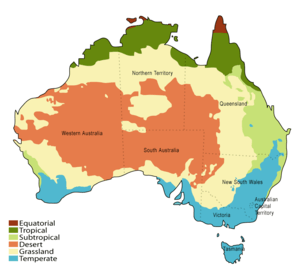
Equatorial Tropical Subtropical
Desert Grassland Temperate
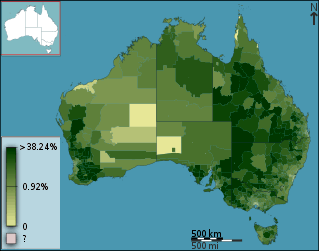
Australia is a major agricultural producer and exporter, with over 325,300 employed in Agriculture, forestry and fishing as of February 2015.[1] Agriculture and its closely related sectors earn $155 billion-a-year for a 12% share of GDP. Australian farmers and graziers own 135,997 farms, covering 61% of Australia's landmass. Approximately 64% of all farms across Australia belong to the state, with a further 23% that are still owned by indigenous groups or tribes. [2] Across the country there is a mix of irrigation and dry-land farming. The CSIRO, the federal government agency for scientific research in Australia, has forecast that climate change will cause decreased precipitation over much of Australia and that this will exacerbate existing challenges to water availability and quality for agriculture.[3]
There are three main zones: the high rainfall zone of Tasmania and a narrow coastal zone (used principally for dairying and beef production); wheat, sheep zone (cropping (principally winter crops), and the grazing of sheep (for wool, lamb and mutton) plus beef cattle) and the pastoral zone (characterised by low rainfall, less fertile soils, and large scale pastoral activities involving the grazing of beef cattle and sheep for wool and mutton).[4] An indicator of the viability of agriculture in the state of South Australia is whether the land is within Goyder's Line.
Major agricultural products
Australia produces a large variety of primary products for export and domestic consumption. The forecast top ten agricultural products by value are listed for the year 2006-07, with production figures from previous years.[5]
| Commodity (in millions of AUD$) | 2001-02 | 2002-03 | 2003-04 | 2004-05 | 2005-06 | 2006-07 |
|---|---|---|---|---|---|---|
| Cattle and calves | 6,617 | 5,849 | 6,345 | 7,331 | 7,082 | 6,517 |
| Wheat | 6,356 | 2,692 | 5,636 | 4,320 | 5,905 | 6,026 |
| Milk | 3,717 | 2,795 | 2,808 | 3,194 | 3,268 | 3,245 |
| Fruit and nuts | 2,333 | 2,408 | 2,350 | 2,640 | 2,795 | 2,915 |
| Vegetables | 2,269 | 2,126 | 2,356 | 2,490 | 2,601 | 2,715 |
| Wool | 2,713 | 3,318 | 2,397 | 2,196 | 2,187 | 2,138 |
| Barley | 1,725 | 984 | 1,750 | 1,240 | 1,744 | 1,624 |
| Poultry | 1,175 | 1,273 | 1,264 | 1,358 | 1,416 | 1,461 |
| Lamb | 1,181 | 1,161 | 1,318 | 1,327 | 1,425 | 1,348 |
| Sugar cane | 989 | 1,019 | 854 | 968 | 1,037 | 1,208 |
Crops

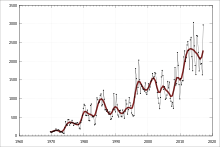
Cereals, oilseeds and grain legumes are produced on a large scale in Australia for human consumption and livestock feed. Wheat is the cereal with the greatest production in terms of area and value to the Australian economy. Sugarcane, grown in tropical Australia, is also an important crop; however, the unsubsidised industry (while lower-cost than heavily subsidised European and American sugar producers) is struggling to compete with the huge and much more efficient Brazilian sugarcane industry.[6] Listed below is crop production by kilotonnes (five year average) for the largest crops:
| Crop (kilotonnes) | New South Wales | Victoria | Queensland | Western Australia | South Australia | Tasmania | Total |
|---|---|---|---|---|---|---|---|
| Wheat | 6714 | 2173 | 1301 | 6959 | 3382 | 23 | 20552 |
| Barley | 1070 | 1173 | 202 | 1511 | 20 | 25 | 5981 |
| Sorghum | 739 | 3 | 1140 | 3 | 0 | 0 | 1885 |
| Cottonseed | 663 | 0 | 1140 | 3 | 0 | 0 | 1806 |
| Canola | 637 | 312 | 1 | 530 | 225 | 1 | 1706 |
| Oats | 360 | 420 | 7 | 588 | 137 | 8 | 1520 |
| Lupins | 140 | 30 | 0 | 1050 | 103 | 0 | 1323 |
| Field peas | 20 | 166 | 0 | 47 | 190 | 1 | 424 |
| Maize | 190 | 8 | 171 | 6 | 0 | 0 | 375 |
| Chickpeas | 86 | 20 | 56 | 29 | 5 | 0 | 196 |
| Lentils | 2 | 68 | 0 | 2 | 56 | 0 | 128 |
| Broad beans | 42 | 68 | 1 | 0 | 14 | 0 | 125 |
| Sunflower seed | 46 | 0 | 65 | 0 | 0 | 1 | 112 |
Horticulture
Australia produces a wide variety of fruit, nuts and vegetables. The largest crops (>300 kilo tonnes, in 2001-2001) include oranges, apples, bananas, chestnuts, potatoes, carrots and tomatoes.
Tropical fruits, including bananas, mangoes and pineapples, fare well in Queensland and the Northern Territory.
Australia is one of the few countries that produce licit opium for pharmaceuticals. This industry, centred in Tasmania, is subject to strict controls.
The horticulture industry has traditionally provided Australians with all their fresh fruit and vegetable needs, with a smaller export industry. However, loosened border controls and increasing importers have threatened local industries. Consumer research has repeatedly shown that Australians prefer local produce. However, there is no effective country-of-origin labelling and consumers frequently assume all fresh vegetables and fruit must be Australian.
In 2005 McDonald's Australia Ltd announced it would no longer source all its potatoes for fries from Tasmanian producers and announced a new deal with New Zealand suppliers. Subsequently, Vegetable and Potato Growers Australia (Ltd.) launched a political campaign advocating protectionism.[7] This campaign included a tractor convoy moving from Tasmania to the mainland (by barge) and then a road trip throughout country Victoria and New South Wales culminating at Canberra, the national capital.
Viticulture
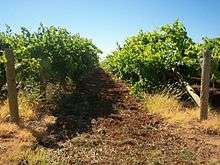
Australia has a large wine industry, and the value of wine exports surpassed A$2.3 billion in 2002-2003. Wine regions include the Barossa Valley in South Australia, Sunraysia in Victoria, Margaret River in Western Australia and the Hunter Valley in New South Wales. The key wine varieties grown in Australia (by area in 2001-2002) are Chardonnay, Shiraz and Cabernet Sauvignon. Although the Australian wine industry enjoyed a large period of growth during the 1990s, over planting and over supply have led to a large drop in the value of wine, forcing some wine makers, especially those on contracts to large wine producing companies, out of business. The future for some Australian wine producers is now uncertain.

Animal products
Beef industry
The beef industry is the largest agricultural enterprise in Australia, and it is the second largest beef exporter, behind Brazil, in the world. All states and territories of Australia support cattle breeding in a wide range of climates. Cattle production is a major industry that covers an area in excess of 200 million hectares. The Australian beef industry is dependent on export markets, with over 60% of Australian beef production exported, primarily to the United States, Korea and Japan.[8] The industry gained an advantage after the discovery of BSE (also known as mad cow disease) in Canada, Japan and the United States, as Australia is free of the disease.
In contrast to breeding systems in other parts of the world, Australian cattle are reared on pasture as the principal source of feed. In southern Australia (NSW, Victoria, Tasmania, South Australia and south-western Western Australia) beef cattle are often reared on smaller properties as part of a mixed farming or grazing operation, but some properties do specialise in producing cattle. The southern calves are typically reared on pasture and sold as weaners, yearlings or as steers at about two years old or older.[9] Artificial insemination and embryo transfer are more commonly used in stud cattle breeding in Australia, but may be used in other herds.[10]
In the Top End, sub-tropical areas and in arid inland regions cattle are bred on native pastures on expansive cattle stations. Anna Creek Station in South Australia, Australia is the world's largest working cattle station.[11] The North Australian Pastoral Company Pty Limited (NAPCO) is now one of Australia's largest beef cattle producers, with a herd of over 180,000 cattle and fourteen cattle stations in Queensland and the Northern Territory.[12] The Australian Agricultural Company (AA Co) manages a cattle herd of more than 585,000 head.[13] Heytesbury Beef Pty Ltd owns and manages over 200,000 head of cattle across eight stations spanning the East Kimberley, Victoria River and Barkly Tablelands regions in Northern Australia.[14] Most cattle from these regions are exported as manufacturing beef or as live animals under 350 kilograms live weight to South-East Asia for fattening in feedlots there.
Prior to European settlement there were no cattle in Australia. The present herd consists principally of British and European breeds (Bos taurus), in the southern regions with Aberdeen Angus and Herefords being the most common. In northern Australia Bos indicus breeds predominate along with their crosses. They were introduced to combine the resistance to cattle ticks and greater tolerance of hot weather.[15]
Despite strong public opposition (a petition carrying 200,000 signatures of people opposed to live export was tabled in parliament[16])and opposition from the RSPCA because of cruelty, the export of live cattle continues.[17]
Lamb meat industry
Lamb has become an increasingly important product as the sheep industry has moved its focus from wool production to the production of prime lamb. The beef meat industry and the lamb industry are represented by Meat and Livestock Australia (MLA). Live export of cattle and sheep from Australia to Asia and the Middle East is a large part of Australian meat export. Live export practices came under scrutiny after the carrier Cormo Express carrying 52 000 animals was turned away from Saudi Arabia in 2003 due to suspected cases of scabby mouth. The sheep were eventually given to Eritrea. Media coverage has led to calls from animal rights activists for the live export trade to cease.
Pork industry

There are currently an estimated 2,000 pig producers in Australia, producing 5 million pigs annually (Productivity Commission). Although relatively small on the world stage (0.4% world production), the industry provides a significant positive impact on local, regional, state, and national economies through income generation and employment. The pork industry contributes approximately $970m to Australia's GDP and the supply chain contributes $2.6billion to the GDP. The industry generates over $1.2b of household income, directly employing 6,500 full-time positions, and the supply chain employs 29,000 people. The Australian pork industry is represented by Australian Pork Limited, a producer-run company created by legislation.
Dairy
Dairy products are Australia's fourth most valuable agricultural export.
Domestic milk markets were heavily regulated until the 1980s, particularly for milk used for domestic fresh milk sales. This protected smaller producers in the northern states who produced exclusively for their local markets. The Kerin plan began the process of deregulation in 1986, with the final price supports being removed in 2000.[18]
Growth in the Australian dairy industry is dependent on expanding export markets. Exports are expected to continue to grow over time, particularly in Asia and the Middle East.
As the Australian dairy industry grows feedlot systems are becoming more popular.[19][20]
Fisheries
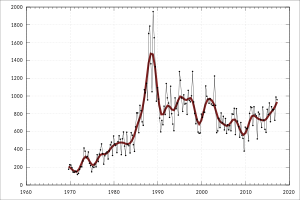
The gross value of production of Australia's fisheries and aquaculture products was $2.3 billion in 2002-03. The Australian aquaculture industry's share of this value has been steadily rising and now represents around 32 per cent. The value of exports of fisheries products in 2002-03 was $1.84 billion. Australia's main seafood export earners include rock lobsters, prawns, tuna and abalone.
Wool

Wool is still quite an important product of Australian agriculture.
In 2001 Australian wool production accounted for 9% of world production (Australian Bureau of Statistics Data). However, it dominates the fine quality wool sector, producing 50% of the world's Merino wool. Although sheep are farmed Australia-wide, 36% of the flock is in New South Wales.
Research and development for the industry are led by Australian Wool Innovation Limited (AWI), a producer owned company. Australian wool is marketed by the Woolmark company. Both companies are held by Australian Wool Services, a company created by legislation.
The industry is export-oriented. Historically, up to 90% of Australian wool was exported. The industry has suffered from a lowering demand for natural fibres, and a decrease in wool prices worldwide.
Animal rights organisations including PETA are currently promoting a boycott of Australian, and all Merino wool, as a protest against the practice of mulesing, a procedure used to prevent the animals from becoming fly blown with maggots.[21] In 2004, due to the worldwide attention, AWI proposed to phase out the practice by the end of year 2010; this promise was retracted in 2009.[22]
Cotton
Australia also produces considerable amounts of cotton. The majority of the cotton produced is genetically modified to be resistant to the herbicide glyphosate or to actively kill pests through the production of Bt toxin (Bt-cotton). Cotton is generally grown by irrigation.
Seaweeds
The shorelines, especially the Great Barrier Reef, are providing motivation to help the continent by using seaweed (algae) to absorb nutrients.[23] Because of the giant number of natural Australian seaweeds,[24] not only could seaweed cultivation be used to help absorb nutrients around the GBR and other Australian shores, cultivation could also help feed a large part of the world.[25][26][27] Even the Chinese, who could be considered far more advanced in seaweed cultivation, are interested in the future of Australian seaweeds.[28] Lastly, the GBR itself, because of the delicate corals,[29] has lent itself to utilizing seaweed/algae purposely as a nutrient reduction tool in the form of algae.[30] This has occurred in the form of algae scrubbers, and seaweed cultivators, which are now available for domestic use worldwide.
Olives
Olives have been grown in Australia since the early 1800's.[31] Olive trees were planted by the warden of the self-funded penal settlement on St Helena Island, Queensland in Moreton Bay.[32] By the mid-90s there were 2,000 hectares (4,900 acres) and from 2000-2003 passed 20,000 hectares (49,000 acres). By 2014 (Ravetti and Edwards, 2014) there were 2000 plantations, covering over 35,000 hectares (86,000 acres), and producing 93,500 tonnes (92,000 long tons; 103,100 short tons) of olives. 3,000 tonnes (3,000 long tons; 3,300 short tons) used as table olives and around 5–7,000 tonnes (4.9–6,889.4 long tons; 5.5–7,716.2 short tons) exported to the United States, China, the European Union, New Zealand and Japan. Between 2009-2014 Australia imported an average of 31,000 tonnes (31,000 long tons; 34,000 short tons) predominantly from Spain, Italy and Greece.[33] China olive oil consumption is increasing and Chinese investors have begun to buy Australian olive farms.[34][35] Olive cultivars include Arbequina, Arecuzzo, Barnea, Barouni, Coratina, Correggiola, Del Morocco, Frantoio, Hojiblanca, Jumbo Kalamata, Kalamata, Koroneiki, Leccino, Manzanillo, Pendulino, Picholine, Picual, Sevillano, UC13A6, and Verdale. Manzanillo, Azapa, Nab Tamri and South Australian Verdale for the production of table olives.[36]
Importance of irrigation
Because of Australia's large deserts and irregular rainfall, irrigation is necessary for agriculture in some parts of the country. The total gross value of irrigated agricultural production in 2004-05 was A$9,076 million compared to A$9,618 million in 2000-01. The gross value of irrigated agricultural production represents around a quarter (23%) of the gross value of agricultural commodities produced in Australia in 2004-05, on less than 1% of agricultural land.[37]
Of the 12,191 GL of water consumed by agriculture in 2004-05, dairy farming accounted for 18% (2,276 GL), pasture 16% (1,928 GL), cotton 15% (1,822 GL) and sugar 10% (1,269 GL).[37]
Issues facing Australian agriculture
Political values
Historian F.K. Crowley finds that:
- Australian farmers and their spokesman have always considered that life on the land is inherently more virtuous, as well as more healthy, more important and more productive, then living in the towns and cities....The farmers complained that something was wrong with an electoral system which produced parliamentarians who spent money beautifying vampire-cities instead of developing the interior.[38]
The Country Party, from the 1920s to the 1970s, promulgated its version of agrarianism, which it called "countrymindedness". The goal was to enhance the status of the graziers (operators of big sheep ranches) and small farmers and justified subsidies for them.[39]

Technical, environmental and economic issues
The major issues facing agriculture in Australia are drought, water security, low soil fertility, weeds, climate change caused by global warming, biosecurity (biological threats from imported foods and livestock), tariffs on Australian exports in the importing country (particularly in Europe and Japan), subsidies to farmers in other countries (see Doha Development Round), currency fluctuations and price volatility. The wheat industry has also faced the end of the "single desk" marketing system after the Australian Wheat Board was found during the Cole Inquiry to have illegally paid bribes to officials in Iraq.
The agricultural industry is one of the most trade-exposed sectors of the Australian economy.[40] According to Charles McElhorn from the National Farmers Federation a 1% change in the value of Australian dollar is equivalent to a change of $220 million in export earnings.
Genetic modification
GM (Genetically modified) grains are not allowed in South Australia, where some grain producers have called for the moratorium to be lifted. They argue the GM technology would help them tackle weeds and other pests, and that farmers should be able to choose how they run their enterprises and whether or not they wanted to grow the 'premium products' described by Leon Bignell, the South Australian (SA) Agriculture Minister. Producers have also said their GM-free grain is not translating to higher profits. Bignell conceded more work needed to be done to market produce as GM-free but said he was confident producers would see higher financial returns in the near future. In March 2015, Bignell told farmers they should not use GM but should instead rely upon what he called 'God's gifts'.[41] He said the "amazing" results of the Government's 'New Horizons' soil improvement program "prove," in his view, that grain producers "do not need genetic modification technology." He said that "Instead of using the top five centimetres of the soil, you go down to 50cm or even deeper. You put clay in it when it's needed, you put organic matter where it's needed as well." Bignell said the trials had strengthened his view that South Australia should maintain a moratorium on GM technology, which he said gave the state's produce a "market edge". Bignell also said he believed results of the New Horizons program could be replicated in all grain growing areas of the state. Bignell added that "If you look at GM and the promises around increases of about seven per cent in yields, why would you go for seven per cent when you can get 50 to 100 per cent increases in yield without having to use genetically modified seeds?"[42]
References
- ↑ Hutchison, Michelle (18 June 2015). "finder.com.au 2015 Careers in Australia Report". finder.com.au. Retrieved 2 April 2018.
- ↑ New reference reveals facts about Australian farming Archived 11 March 2011 at the Wayback Machine. Retrieved 30 January 2011
- ↑ Preston, B.L.; Jones, R.N. (February 2006). "Climate Change Impacts on Australia and the Benefits of Early Action to Reduce Global Greenhouse Gas Emissions" (PDF). CSIRO Marine and Atmospheric Research. Archived from the original (PDF) on 25 February 2009. Retrieved 25 January 2009.
- ↑ Shaw, John H., "Collins Australian Encyclopedia", William Collins Pty Ltd., Sydney, 1984, ISBN 0-00-217315-8
- ↑ "Gross value of farm and fisheries production". Australian Commodities. ABARE economics. 13 (2): 438 and 439. June 2006.
- ↑ Clive Hildebrand (2002). "Independent Assessment of the Sugar Industry" (PDF). p. 5. Retrieved 18 January 2018.
- ↑ Fair dinkum! Hinch calls 'pointy-head Tasmanian' campaign doomed 1 August 2005, ABC Tasmania, Louise Saunders. Accessed 9 August 2011
- ↑ Country Leader, 31 January 2011, Farm Facts: Beef is bullish, Rural Press
- ↑ "Agriculture - Beef Industry - Australia". Australian Natural Resources Atlas. Australian Government. Archived from the original on 22 August 2011. Retrieved 15 August 2011.
- ↑ Beattie, William A., Beef Cattle Breeding & Management, Popular Books, 1990, ISBN 0-7301-0040-5
- ↑ Mercer, Phil (9 June 2008). "Cattle farms lure Australian women". BBC. Retrieved 9 June 2008.
- ↑ "North Australian Pastoral Company". napco.com.au.
- ↑ "AACo". aaco.com.au. Archived from the original on 29 March 2007.
- ↑ "Heytesbury Cattle Company". heytesburycattle.com.au.
- ↑ Austin, Nigel (1986). Kings of the Cattle Country. Sydney: Bay Books. ISBN 1-86256-066-8.
- ↑ "Live Export Petition Exceeds 200,000 Signatures // Animals Australia". AnimalsAustralia.org. Retrieved 2 April 2018.
- ↑ "Archived copy". Archived from the original on 23 September 2014. Retrieved 2014-09-24.
- ↑ Pip Courtney (25 June 2000). Dairy deregulation rolls on despite protests. Landline. Australian Broadcasting Corporation.
- ↑ Deanna Lush (24 April 2003). "SA develops a taste for feedlot systems". stockjournal.com.au. Archived from the original on 13 December 2014. Retrieved 24 September 2014.
- ↑ http://www.dairyaustralia.com.au/~/media/Documents/Animal%20management/Feed%20and%20nutrition/Feeding%20Systems%20latest/Aus%20five%20main%20feeding%20systems.pdf%5Bpermanent+dead+link%5D
- ↑ "Pink angers Australian government". BBC News. 20 December 2006. Archived from the original on 10 January 2007. Retrieved 9 January 2007.
- ↑ Peter Wilkinson (8 November 2004). "In the News". Australian Wool Growers Association. Archived from the original on 24 September 2006. Retrieved 9 January 2007.
- ↑ "Nutrient Absorbers". 2000. Retrieved 9 March 2015.
- ↑ "Australian Seaweeds". 2015. Retrieved 9 March 2015.
- ↑ "Ideas bloom for seaweed cultivation on the South Coast". 24 June 2014. Retrieved 9 March 2015.
- ↑ "Seaweed as Human Food". 2015. Retrieved 9 March 2015.
- ↑ "Could seaweed farming be Australia's next aquaculture industry?". 13 January 2015. Retrieved 9 March 2015.
- ↑ "Chinese company invests in Aus seaweed, hopes to start farming". 8 March 2015. Retrieved 9 March 2015.
- ↑ "The Implications of Climate Change for Australia's Great Barrier Reef". 1988. Retrieved 9 March 2015.
- ↑ "Nutrient cycling in the Great Barrier Reef Aquarium". 1988. Retrieved 9 March 2015.
- ↑ Newton, John (13 March 2012). "A Hardy evergreen". The Sydney Morning Herald. Retrieved 19 July 2018.
- ↑ "The remarkable story of the Helena". Treetops Plantation. Retrieved 19 July 2018.
- ↑ "Olive growing in Australia" (PDF). Town and Country Farmer. March–April 2016. Retrieved 19 July 2018.
- ↑ Hall, Simon (with Stewart, Robb M.) (18 February 2014). "China Feeds Rush for Australian Olive Oil". The Wall Street Journal. Retrieved 19 July 2018.
- ↑ Sinclair, Hannah (1 September 2017). "Chinese investment in WA olive farm a boost for local workers". Special Broadcasting Service (SBS). Retrieved 19 July 2018.
- ↑ "A guide to Olive Variety Selection" (PDF). Australian Plants. 1 September 2017. Retrieved 19 July 2018.
- 1 2 "Drought drives down water consumption". Australian Bureau of Statistics. 28 November 2006. Retrieved 25 January 2009.
- ↑ F.K. Crowley, Modern Australia in Documents: 1901 – 1939 (1973) pp 77-78.
- ↑ Rae Wear, "Countrymindedness Revisited," (Australian Political Science Association, 1990) online edition Archived 23 July 2011 at the Wayback Machine.
- ↑ "Dollar's decline a mixed blessing". ABC News. Australian Broadcasting Corporation. 15 May 2012. Retrieved 15 May 2012.
- ↑ Grindlay, Danielle. SA Agriculture Minister says soil program proves utilising 'God's gifts' can boost yields better than GM technology (March 2015), Australian Broadcasting Corporation
- ↑ Grindlay, Danielle. SA Agriculture Minister says soil program proves utilising 'God's gifts' can boost yields better than GM technology (March 2015), Australian Broadcasting Corporation
External links
![]()